#sbc computer
Explore tagged Tumblr posts
Text
why do i have pixelation on face shadows and edges literally all my settings are on ultra with selective ray tracing is this dlss’ fault…
#no pixelation on hair whatsoever and i don’t notice it anywhere else#what are you guys’ setting sbc this has been irritating me since the beginning but it’s gotten worse since the first patch#dlss made bg3 look too crunchy to me so like is that what’s happening#my computer is very much above minimum specs like that’s not an issue#i’ll find any detail to obsess over and get frustrated by like it’s always something#.txt
5 notes
·
View notes
Text
Got a cheap bluetooth dongle so I can get bluetooth audio on my PC.
(Yes I know I recommend everyone have a wireless card in their desktop purely for this eventuality. I have a motherboard that can accept a wireless M.2 card. I just didn't use it. I have plans.)
Anyway. I finally have a good driver stack and hardware to try SBC-XQ. Didn't want to work on my laptop for some reason. I think that SBC-XQ is the funniest bluetooth codec. Sony and Qualcomm put quite a lot of proprietary effort (and patents) behind LDAC and Apt-X HD respectively but Shannon is the deadliest son of a bitch in the world of information transmission so it turns out just juicing the bitrate on SBC to 512kbps comes out more or less perceptually identical to Apt-X HD at 512kbps. SBC-XQ requires absolutely zero other changes and is often completely backwards compatible.
LDAC/LHDC pushes more detail but at its highest bitrate it needs a stupendous ~1000kbps and is, once again, basically indistinguishable from SBC-XQ in all but the most perfect listening environments.
Truly the 320kbps Opus of Bluetooth codecs.
10 notes
·
View notes
Text
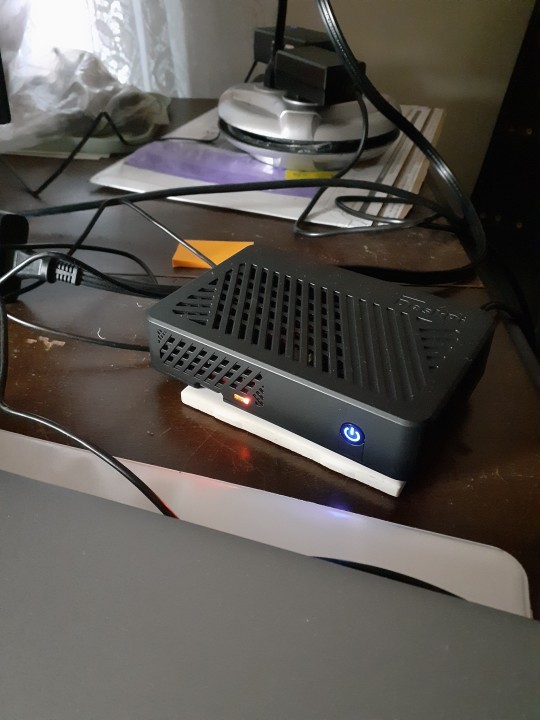
I was explaining BBS to someone and the very personal in the impersonal world of the internet hit hard this morning.
When you visit my BBS you are here, literally controlling this tiny computer on my desk, in my office, in my home.
It's not a server farm, some AWS or Microsoft tank submerged in the cooling sea water.
How wild is that.
For a little while, you are here. Giving this silicon and wire construct a touch of humanity.
5 notes
·
View notes
Text

ARMxy RK3588 Industrial Gateway Bacnet to MQTT for Building Management Systems
BL450 Series ARM Embedded Computer is an industrial-grade ARM controller with flexible I/O configuration, based on the Rockchip RK3588J/RK3588 processor, featuring a quad-core ARM Cortex-A76 + quad-core ARM Cortex-A55 + triple-core ARM Cortex-M0 architecture, witha clock speed of up to 2.0G/2.4GHz. It is equipped with 32GB/64GB/128GB eMMC and 4GB/8GB/16GB LPDDR4X RAM and ROM configurations. Supporting a rich set of I/O interfaces, it also integrates a 6TOPS NPU, enabling deep learning capabilities. The BL450 series iswidely used in industrial control, edge computing, AIoT, artificial intelligence, communication management, AGV robots, machine vision inspection, robotics, industrial IoT gateways, energy storage systems, automation control, and transportation infrastructure.
BL450 Series ARM Embedded Computer offers 1 to 3 optional RJ-45 network ports, including two 10/100/1000M ports and one 10/100M adaptive port, along with 2×USB 3.1, one optional HDMI 2.1, and optional X-series and Y-series I/O boards for communication, PWM output, pulse counting, and other data acquisition and control functions. It supports 8K@30fps H.264 video encoding and 8K@60fps H.265 video decoding. Built-in Mini PCIe interface allows support for Bluetooth, WiFi, 4G, and 5G communication modules.
BL450 Series supports multiple operating systems, including Linux-5.10.209, Linux-RT-5.10.209, Ubuntu 20.04, Debian 11, and Android 13. It is also compatible with Docker containers, Node-Red, and Qt-5.15.10 for graphical development. The BLIoTLink industrial protocol conversion software enables fast industrial data acquisition and conversion, facilitating seamless integration with mainstream IoT cloud platforms and industrial SCADA software. Additionally, the BLRAT remote access tool provides remote access and maintenance, while Node-Red allows for rapid IoT application development.
Designed with professional electrical performance and high/low-temperature testing, the BL450 series operates reliably under harsh electromagnetic interference and extreme temperatures ranging from -40°C to 85°C. With DIN35 rail mounting, it is suitable for various industrial applications.
0 notes
Text
1 note
·
View note
Note
Cactus fascinates me, does it run on code similar to an existing instruction set or is it completely original on that front?
What can you do with it? What's it's storage?
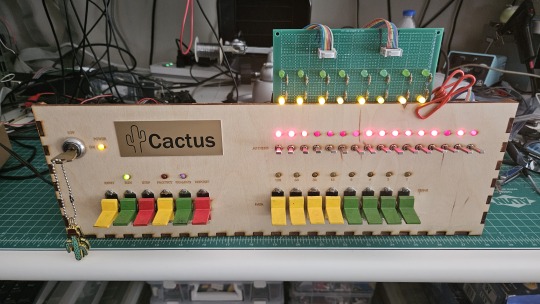
Both the Cactus (the original wooden prototype from years ago) and the new PCB Cactus(es) are essentially derived from a minimal 6502 computer design by Grant Searle for their core logic. Here's what that would look like on a breadboard:
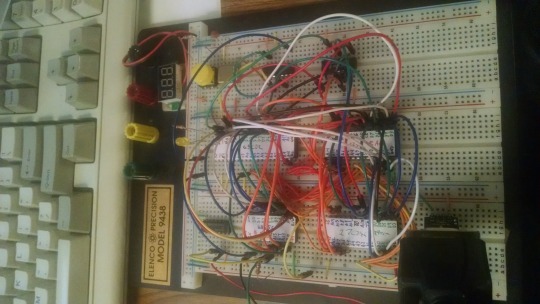
There isn't much to it, it's 32K of RAM, 16K of ROM containing Ohio Scientific's version of Microsoft BASIC, a 6850 ACIA for serial interaction, some logic gates, and of course a 6502 microprocessor (NMOS or CMOS, doesn't matter which). You hook it into a terminal and away you go.
Grant's design in turn can be best described as a distilled, modernized version of the OSI Challenger series of computers. Here's an OSI-400 and a Challenger 4P respectively:
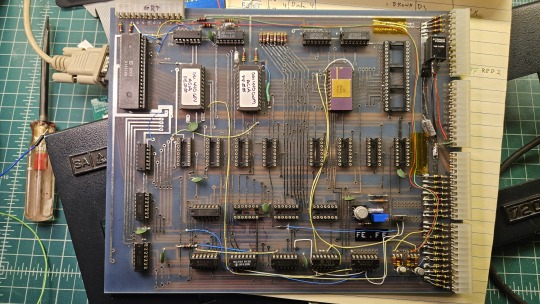

The left one is a replica of the 400 circa 1976, also called the Superboard. It was affordable, endlessly reconfigurable and hackable, but ultimately very limited in capabilities. No BASIC, minimal monitor ROM you talk to over serial, but you could connect it to a bus to augment its features and turn it into a more powerful computer.
Whereas the OSI C4P on the right from about 1979 has more RAM, a video card, keyboard, BASIC built in, serial interface, cassette tape storage, and that's just the standard configuration. There was more room to expand and augment it to your needs inside the chassis (alot changed in 3 years for home computer users).
Grant's minimal 6502 design running OSI BASIC is a good starter project for hobbyists. I learned about the 6502's memory map decoding from his design. I modified and implemented his design on a separate cards that could connect to a larger backplane.
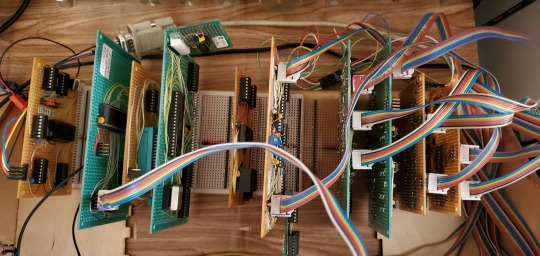
Here are the serial, ROM, RAM, and CPU cards respectively:
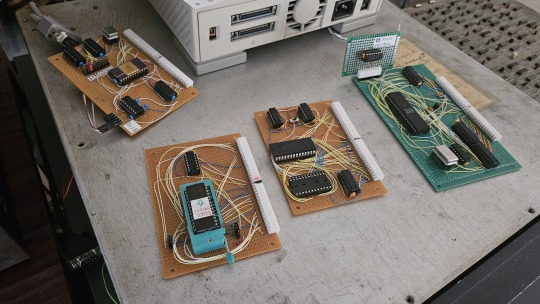
Each one is 100% custom, containing many modifications and fixes as I developed the design. However, that's only half of the computer.
I really wanted a 6502 machine with a front panel. People told me "nobody did that", or couldn't think of examples from the 1970s but that seemed really strange to me. Especially since I had evidence to the contrary in the form of the OSI-300:
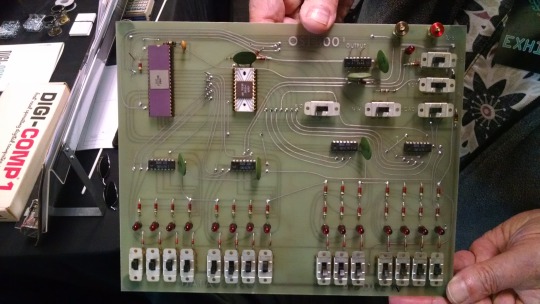
This one I saw at VCF West back in 2018 illustrates just how limited of a design it is. 128 bytes of RAM, no ROM, no serial -- just you, the CPU, and toggle switches and LEDs to learn the CPU. I was inspired the first time I saw one in 2015 at VCF East, which is probably when this whole project got set in motion.
Later that year I bought a kit for a miniature replica OSI-300 made by Christopher Bachman, and learned really quickly how limited the design philosophy for this particular front panel was. It was a major pain in the ass to use (to be clear, that's by OSI's choice, not any fault of Christopher in his implementation)

So... I designed my own. Took awhile, but that's the core of what the Cactus is: my attempt at experiencing the 1970s homebrew scene by building the computer I would have wanted at the time. Over half of the logic in the Cactus is just to run the front panel's state machine, so you can examine and modify the contents of memory without bothering the 6502. I added in all of the things I liked from more advanced front panels I had encountered, and designed it to my liking.
Here's the original front panel, accompanying logic, and backplane connected to the modern single board computer (SBC) version of the machine:
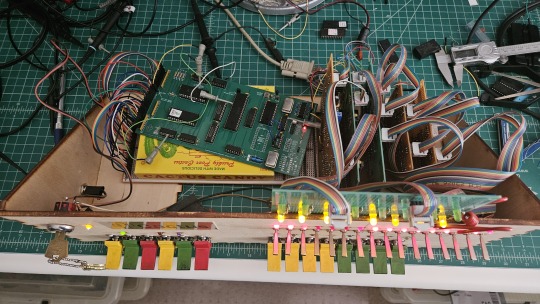
And here's the new Cactus SBC working with the new front panel PCB, which combines the logic, physical switch mountings, and cabling harnesses into a single printed circuit board.
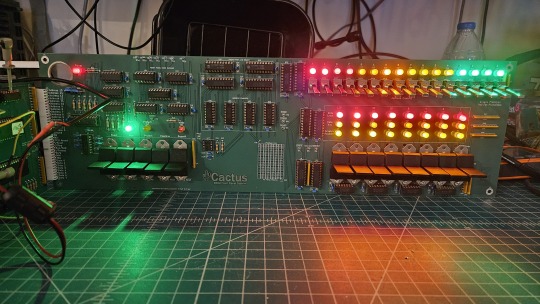
So, what can you do with it? Pretty much the same things I do already with other contemporary 1970s computers: play around in BASIC, fire up the occasional game, and tinker with it.
I've got no permanent storage designed for the Cactus as yet, it's been one of those "eventually" things. The good news is that a variety of software can be ported to the hardware without too much trouble for an experienced hobbyist. A friend of mine wrote a game called ZNEK in 6502 assembly which runs from a terminal:
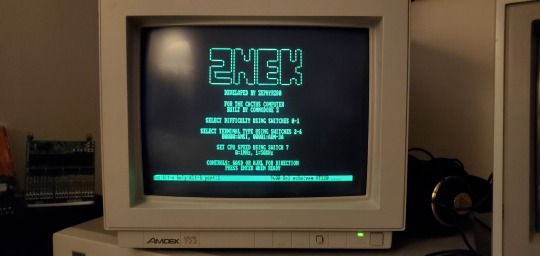
Right now, you have to either toggle in machine programs from the front panel from scratch, burn a custom ROM, or connect it to a serial terminal to gain access to its more advanced features:

Here's it booted into OSI BASIC, but I have also added in a modern descendant of Steve Wozniak's WOZMON software for when I need to do lower level debugging.
I've also got a video card now, based on the OSI-440. I have yet to implement a keyboard, or modify BASIC to use the video board instead of the serial connection. Even if I did, screen resolution is pretty limited at 24x24 characters on screen at once. Still, I'm working on that...
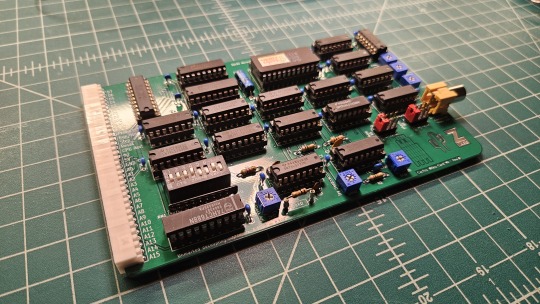

Anyway, I hope that answers your question. Check the tags below to see the whole process stretching back to 2017 if you're curious to learn more of the project's history. I'm also happy to answer any more questions you might have about the project.
267 notes
·
View notes
Note
Ever heard of collapse OS?
Yeah. I haven't looked into it too closely. I think it's an interesting idea (for anyone else, it's an operating system designed to be used post-society-collapse: it runs on low powered and homemade computers) but I don't think it's very likely to be useful.
I think in any sort of "society has collapsed and we can't make new computers!" situation, the vast majority of computer use will be of existing computers. People will run laptops off solar panels and such. And in those cases, I think the existing OSes are going to be the most useful, since they have plenty of software already existing for them, not to mention they're already installed on those computers.
Plus Forth is a strange choice. Like, I understand WHY Forth, it's easy to implement and runs on anything, but I think the problem is that most programmers don't know Forth. And it's not common enough that there's gonna be books left over that you could get from the ruins of a library or bookstore.
So just like OSes, the answer for "what language will we use after a societal collapse?" is probably just gonna be "the same ones we currently use, mostly. Because we have books for those."
I could see this project being more reasonable as a book, though. Teach the reader forth and then collapse OS, maybe include an SBC that can run it?
In any case: I think it's really only got value as a thought experiment, and as one I don't find it super-interesting or enlightening. It's a good idea to think now about how you could use computers after a major (or even minor) collapse, but I think this isn't a very realistic answer. As a project by a single guy for fun? Sure.
149 notes
·
View notes
Note
Out of curiousity, how did you get into doing this sort of computer work? Especially more low level stuff. :]
How can other people get into it / what would you like to see people make in the future in this area?
- Aspiring Programmer
I was an extremely poor kid, in middle school I learned about piracy which led to me getting into FOSS software for media conversion so I could load a bunch of media onto my psp. A short time later I learned about cfw, custom firmware, for psps when I was trying to figure out how pirating games for the system worked, that led to my first hardware hacking, at the time you needed to make a "magic battery" in order to save money on hacking the system which luckily for me I was able to do with a busted battery. That was really my big start because it was so exciting to be a poor kid with access to tons of games and media all of a sudden. Since then I've been very interested in firmware work and embedded systems, though I definitely didnt know thats what it was at the time.
For getting into software/hardware hacking/programming in a similar way I'd seriously recommend getting a cheap SBC, something like a Raspberry Pi Zero or just a Raspberry Pi is a good place to start especially since there are tons of projects for those boards that you can hack on and tons of very useful programs like pi-hole which does DNS ad blocking.
As to what I'd like to see people do: more projects dealing with media on these kinds of systems, video djing, glitch art, etc, because usually you're limited to something like VLC for media.
36 notes
·
View notes
Text
the party walkers
self insert .✧・゚: *✧・゚:* school bus graveyard
words: 2.21k
next part: a rescue mission
note: hot minute, hey guys, this is my first time writing for school bus graveyard! currently, it's probably my favorite webtoon (that being said, all my other favorites are on hiatus, so, yk. that's that.) if you followed me for genshin one shots, I just wanna let you know I'm NOT gonna stop writing them, permanently at least. I haven't been able to fixate on genshin for a bit because the app is too big for my phone and trying to play on my computer kills me inside. hope you enjoy, also things prooobably aren't gonna be perfect, lol, I'm going off memory of the first chapter/s
content: self insert for sbc, uh, go read that first, I don't think I'll end up including anything (at least, not here) that needs extra trigger warnings. long term, it's a tyler x reader, maybe, idk, but regardless I don't plan on starting that for a bit.

i. a demon inside of my skin
you hadn't been in "the room where it happened", so to speak. actually, you didn't know what everyone else was dealing with for about a week after savannah, because you thought you were having batshit crazy nightmares! your hotel room was a good bit further away from everyone else's that first night, and after making a run for it into a room and barricading yourself in, you thought that would be the end of it. everyone did, didn't they?
and then, you went home. warm bed, soft blanket, box fan running in the background while you scrolled through various social media apps. it was nearing midnight, but that wasn't new for you. the early morning hours were your friend, the moon a sibling by your teenage years. not unique, sure, but that was the reality of that situation. a small shiver tickles your spine as you remember the night mare last night brought you, your fingertips ghosting the spot on your knuckle where you had banged it and broken your finger in that dream. it was even sore when you woke up. sometimes, nightmares were like that though. sometimes people woke up gasping for air after drowning in their sleep, or craving cigars after being a smoker in their dreams. sore knuckles weren't that far off.
it was like a flash; one moment, you were watching a college aged blonde talk about the type of oils she used for her long, silky, soft hair, and the next, the sky from out your window was a bleeding carmine. there was a loud silence, no wind, no rain, no box fan or phone.
then, again, you heard it. click, click, click. chatter, chatter, chatter. okay. cool. another nightmare. fun and fantastic.
shooting out of your sheets, your index finger throbbed, sparing a second and glancing at it revealed purple spots upon green bruises splotched along your hand. curling your finger inward hurt, but was possible. making a fist around your blanket, you threw it as hard as possible off of you, hoping to distract whatever was making the noise. it did not have the desired affect, and flew a couple feet before expanding and landing softly on the floor. that didn't matter, you were already on your feet and they were thudding to your door before you were aware of what was going on, scrambling on the carpet of your bedroom as you heard skitter like movements from where your eyes couldn't catch the gray, uncanny human-like figure making its way toward you on all fours. it was fast. way, way too fast. the undignified squeal you released as you yanked open your door turned into a gravelly scream of both terror and agony when you slid through, slamming the door shut before you, a blackened finger along with it. it didn't fall to the floor, but instead was hanging painfully out of your back, right under your shoulder blade. like a when a plank of wood splinters, but has enough fibers to hang off and out of the main piece and bobs back and forth. except you're not a piece of wood, and you have to not scream right now.
you feel nausea drinking its way into your chest, but adrenaline pushes it to a back burner as a need to survive pulses in your brain. grabbing a random shoe, a picture frame from off the wall, and a small ball which were left on the floor earlier, you throw them in another direction and hope it sounds enough like footsteps that when you get into the bathroom, whatever that thing is doesn't try to follow you in there.
the balls of your feet aren't much quieter than your whole foot, but they'll have to do as you nearly slam the bathroom door, stop yourself in the knick of time to edge it closed instead, and lock it. for the first time in your entire life, you internally thank your parents that you didn't get that house with the skylight in the bathroom.
now, you hold your breath. the creaking of the floors beneath your cheap carpet tells you that that thing, that monster, that whatever-it-is, is passing by. your fingers shake as you cover your mouth with one hand, the other cupping your nose as you try desperately to slow and quiet your breathing. unfortunately, the racing of your heart isn't helping, and neither is the recognition of that wound that craved up your back so nicely. again, your stomach turns. you don't have time to deal with that right now, even if you can feel blood dripping down your back and throbbing which matches your heartbeat.
click, click, thump, thump. the shadow from the light outside darkens, two fuzzy shadows before the door. silence. praying.
click, click. click. it slowly, slowly, drags its hideous feet away from the door.
you can't breathe for another minute, and the instant you do, it comes out as a heave. your eyes go wide as you scramble toward the bathtub, making it just in time to spill your guts. after emptying your stomach, you pull away with watery eyes and a raw throat, coughing a couple times. you feel a little bit better, as you usually do after throwing up, but that won't last. also, you need water, and that means looking in the mirror if you don't wanna be loud. but for right now, you just need to lay down for a moment. just breathe. you're so, so light headed. you had only just woken up, and this all felt so real. the pain in your hand and in your back. the scratchy stinging you feel up your esophagus. the exhaustion pawing under your eyes as you start to lean backward;
except, you can't, and when you try that, you only shoot straight up and nearly puke all over again. thankfully, this time, the finger actually falls out of your back.
"𝘳𝘪𝘨𝘩𝘵. 𝘐 𝘴𝘩𝘰𝘶𝘭𝘥 𝘢𝘤𝘵𝘶𝘢𝘭𝘭𝘺 𝘵𝘢𝘬𝘦 𝘤𝘢𝘳𝘦 𝘰𝘧 𝘵𝘩𝘢𝘵, 𝘵𝘩𝘦𝘯."
you can reach the majority of the wound if you really reach. it won't be perfect, but you should be able to get it properly clean and bandaged with the first aid kit your family keeps in the bathroom. you don't really know how to clean a wound this big, though. will you need stitches? the only real way to know is to look at it, even if you aren't really ready to do so.
"𝘸𝘩𝘺 𝘢𝘮 𝘐 𝘸𝘰𝘳𝘳𝘪𝘦𝘥 𝘢𝘣𝘰𝘶𝘵 𝘵𝘩𝘪𝘴? 𝘪𝘧 𝘐'𝘮 𝘢𝘴𝘭𝘦𝘦𝘱, 𝘵𝘩𝘪𝘴 𝘪𝘴𝘯'𝘵 𝘢𝘤𝘵𝘶𝘢𝘭𝘭𝘺 𝘢 𝘣𝘪𝘨 𝘥𝘦𝘢𝘭."
the thought came to you before you even moved from your spot on the floor. oh, yeah. that's right. you're asleep.
...
huh. most dreams feel a little more, don't know. dreamy?? if this is a dream, candy is going to start raining from the sky right now.
right now. here.
𝘯𝘰𝘸, you think, looking up at the ceiling half heartedly. alright, if this was a nightmare, it was a really weird horrible one. and also, you'd rather not push your luck at this point. so, mirror it is. ignoring the pit of panic welling in your chest, you push yourself to your feet, and tip toe to the kitchen sink. you stare at the faucet, and then force your eyes upward. your hair is frazzled, and there are white specks along the corners of your mouth. and then, you turn around. your jaw tightens when you see the open wound, your nightshirt torn open and revealing tattered, aggressive flesh beneath it. that thing probably cut you to the bone. hopefully, because there is in fact a bone there, it didn't hit any organs. you can breathe fine, so your lung didn't seem all too punctured. it's just ugly. ugly and painful.
cleaning it is the first step, and you're just thankful that despite the fact that you stupidly, stupidly, stupidly dumped isopropyl alcohol onto it in hopes of doing so (for a second, before the burning, you felt a little uncomfortable. and then it hit, you nearly cracked your tooth from biting down so hard), it's over with.
a week later, you find yourself in class, rubbing sleepiness from your eyes. so, long story short, that wasn't a dream, and something is horribly wrong. you waking up to a long scab running down your shoulder blade told you that much. and things were about to get a lot worse. in the real world, that is.
"sir, please. they do literally nothing. they just sit there all spaced out, rubbing their eyes. it's like they aren't even trying for this project!" brandy, your classmate begs in a hushed tone. as annoying as the brunette could be at times, she wasn't wrong. a pang in your chest as you think of possibly making it so that the other members of your group protect fail because you are too tired to do your part. god, sorry brenda, you're too busy trying to huddle up in a bathroom all night and take care of a wound that isn't healing for some reason, all while praying that the thing that chased you in there and will probably kill you, doesn't murder you. but she's still not wrong. and it isn't like she knows that, because you have something seriously wrong with you. it's not her fault, and she shouldn't have to pay for you being crazy.
"mr. thomas," you quietly call, rubbing your elbow uncomfortably as you stare at the floor. you can see brandy pause from the corner of your eye, and you think there's even a sorry expression on her face. even if she was annoying, she clearly hadn't thought you heard that. and she had a right to be upset.
"I would like to change groups, if, um, possible."
there's a pause, and from your peripheral view, you can see your teacher and classmate motioning at each other, her probably trying to convince him to let you do so. a small thump, and then a sigh. "alright. I'm going to put you with ashlyn's group. "
as a redhead from across the room pops up and looks around, mr. thomas looks through a few pieces of paper, crossing something off with his pen. he didn't say it out loud, and frankly, he didn't have to. that was the group in the class that was also failing, so, you being in it wouldn't have much of an impact anyway. at least you wouldn't sink the whole ship all by yourself. was it smart, as a teacher? no. he probably should have put you with a tutor or something. looking up at mr. thomas as you nod and collect your things from your desk reveals an, in fact, apologetic eyed brandy. she mouths a "thank you", and you nod in return. you would drag your chair to their little group later, first, you should go introduce yourself, and hope they don't kick you out.
the bright blonde of the group catches you with his eyes before anyone else. you can hear him say something, and the rest of them stop talking and turn to look at you as you awkwardly walk over. their eyes are so piercing, it's making you uncomfortable.
"can we help you?" a brunette asks, tilting her head up to look at you. her tone carries no malice, just curiosity. makes you feel a little bit better.
"I'm so sorry to ask this, if you guys don't want me in your project I'll go ask if I can be alone or join another group or something, it's not a big deal. I'm having issues with my part of the project, and it's affecting everyone else's work in my group. so they were wondering if I could join in with you guys."
they all share a really weird look with each other, like they're talking telepathically or something. a tense moment passes, and two members speak up at the same time.
"yeah sure lol."
"fuck no."
"tyler! be nice! besides, we probably need someone who actually knows what's going on in this class!"
"didn't she just say she was having issues with her work? it's not like she's going to add much."
"to be fair, I don't think any of us are doing all too great on the work anyway."
you feel the need to clarify, mainly to get this over with. "I'm not really having trouble with the work. I'm just not doing it. I'm having sleeping issues, again, not a big deal if you don't want me to join."
they all stop, and look at you again. the redheaded one narrows her eyes, letting the braid she was messing with fall to her lap. her and the boy next to the brunette girl who asked you a question - actually, now that you're up close and looking at him, that looks like one of the boys on the baseball team. didn't she call him tyler? like tyler hernandez? huh. you didn't even realize you guys shared this class.
"what kind of nightmares have you been having?" the blonde asks, looking at who you're starting to assume is ashlyn. they have a staring contest of sorts while you start to answer. "oh, just weird ones. like, ones with monsters... and stuff..."
you didn't say anything about nightmares.
he looks at you again, a cat like grin on his face. "I think you should sit down. "
✧・゚: *✧・゚:*
next part: a rescue mission
#sbg#school bus graveyard#tyler sbg#tyler#tyler hernandez school bus graveyard#x reader#xreader#x y/n#xy/n#dummie-writes#oneshot#self insert#self-insert#sbc self onsert#ash#ashlyn#ashlyn sbg#ashlyn school bus graveyard#ben#ben sbg#ben school bus graveyard#aiden#aiden sbg#aiden school bus graveyard#taylor#taylor sbg#taylor school bus graveyard#logan#logan sbg#logan school bus graveyard
58 notes
·
View notes
Text
met with the interim therapist yesterday
she now agrees that i have made a good faith effort with the new p.a. and that it is reasonable to try to find someone else
she also put our work on hold indefinitely
next week i need to do something but i am not sure what or how
--
[not sure if this should have a trigger warning, but my enthusiasm for certain kinds of technology is only loosely moderated]
i ordered an open source watch
it is on the proverbial slow boat from china
i tend to burn through watches quickly
so it makes sense to get a somewhat modular one that i can maintain myself (that is my lame excuse to buy a new toy)
it will also be my first experience with e-ink
it is based on an sbc (single board computer) that i have used before, so i can go into the open source code to add my own mods (the board, esp32, can be be programmed to be a controller board for a printer or other cnc machine) (speaking of printers, i need to print a case for the watch) (later, if the need is great, i can mill a case from an aluminum blank)
the watch has wifi, so there is a lot i can do with it
it is a new toy that should give us plenty of new puzzles to be solved
3 notes
·
View notes
Text

ARMxy RK3568B2 Industrial IoT Gateway TimescaleDB for Scalable SQL-based Time-Series Data
The ARMxy BL410 series is a versatile industrial ARM controller designed for flexible I/O configuration. It is based on the Rockchip RK3568J/RK3568B2 processor, featuring aquad-core ARM Cortex-A55 architecture with clock speed up to 1.8GHz/2.0GHz. The device is equipped with 8/16/32GB eMMC storage and various combinations of 1/2/4GB LPDDR4X RAM. Additionally, it includes a built-in 1TOPS computing power Neural Processing Unit (NPU) for supporting deep learning tasks.
The BL410 series ARM embedded computer offers a rich array of interfaces including
3 x 10/100M Ethernet ports, 2 x USB 2.0 ports, 1 x optional HDMI 2.0a port, 1 x optional X series IO board, 2 x optional Y series IO boards. These interfaces support various functions such as communication, PWM output, pulse counting, and data acquisition and control. The BL410 also supports hardware decoding of 1080P@60fps videos.
Additionally, it features a built-in Mini PCIe interface to support communication modules such as Bluetooth, WiFi, and 4G modules.
The BL410 series ARM embedded computers support Linux-4.19.232, Linux-RT-4.19.232 kernels, Debian-10.13, Android 13, Docker containers, Node-RED, and Qt-5.15.2 for graphical interface development tools. In addition, BL410 is compatible with BLIoTLink industrial protocol conversion software for data collection and transformation, and can seamlessintegration with various mainstream IoT cloud platforms and industrial SCADA software. Users can leverage the BLRAT for remote access and maintenance of the BL410 embedded computer. Additionally, with support for Node-Red, users can rapidly develop IoT applications on the BL410.
The BL410 series ARM embedded computer has undergone rigorous electrical performance design and high-low temperature testing to ensure stability and reliability. It is designed for DIN35 rail mounting, making it suitable for various industrial application environments.
This embedded computer is widely used in industrial IoT, photovoltaic power generation and energy storage systems, automation control, and transportation and rail applications.
0 notes
Text
#sbcs#sbc#raspberry pi#banana pi#linux#explaining#computers#open source#top 5 list#tech#christopher burnette#christoper barnette
1 note
·
View note
Text
Realidade aumentada e a imersão com dispositivos: uma experiência

A cibercultura traz à vida ideias e conceitos que são pensados e desenhados pelas artes e pela ciência. Quem nunca assistiu a um filme ou desenho em que a realidade aumentada deu o tom da narrativa? Acesso a mundos e espaços virtuais onde era possível todo e qualquer tipo de interação? Quantos não são os livros e artigos que teorizam e preveem um futuro cada mais pautado na relação entre humanos e tecnologias?
Pois é, esses sonhos e expressões tendem a se tornar realidade num ritmo cada vez mais acelerado e não tem sido difícil encontrar experiências, por exemplo, no campo da educação que comprovem a imersão entre o virtual e a vida cotidiana. É o caso da vivência da turma da disciplina Educação e Cibercultura, componente curricular do Programa de Pós-graduação em Educação da Universidade Tiradentes.
Numa imersão que uniu a turma com uma representante da Ada Metaverse, uma startup de neuroenganharia que cria experiências educacionais no campo do metaverso, foi possível experimentar o conteúdo de realidade aumentada produzido para turmas da disciplina de anatomia. O princípio é simples: viabilizar um laboratório de anatomia humana virtual, em que seja possível para os estudantes visualizar as peças do corpo com uma qualidade de imagem maior que a dos livros e sem os problemas e limitações de um laboratório físico.
A experiência segue todos os preceitos do que é a realidade aumentada, definida como “enriquecimento do mundo real com informações virtuais [...] geradas por computador em tempo real” (Kirner e Kirner, 2011p. 16) e trouxe ainda aspectos como interação com o mundo real e o alinhamento espacial entre os dois, algo pontuado por Azuma (2011). Na prática, quem participou da experiência pôde, por meio da utilização de óculos especiais, interagir com uma simulação de corpo humano, conhecer especificidades técnicas de peças específicas e tudo isso, sem perder o contato visual com a sala de aula física onde todos estavam situados.
De certo, esse tipo de experiência é uma possibilidade muito rica para a promoção de uma formação mais completa, que abarque, além dos aspectos técnicos de disciplinas, questões que envolvem ética, democratização de acesso e letramento para as mídias e dispositivos tecnológicos. Afinal, aprender na cibercultura é uma ação que pressupõe imersão e exploração de novas linguagens e recursos, algo que está contemplado em vivências com a realidade aumentada.
Referências
AZUMA, R., et al. Recent advances in augmented reality. IEEE computer graphics and applications, v. 21, n. 6, p. 34-47, 2001.
KIRNER, C.; KIRNER, T.G. Evolução e Tendências da Realidade Virtual e da Realidade Aumentada. In: Ribeiro, M.W.S.; ZORZAL, E.R. (Org.). Realidade Virtual e Aumentada: Aplicações e Tendências. Realidade Virtual e Aumentada: Aplicações e Tendências. 1 ed. Porto Alegre: SBC, 2011, v. 1, p. 8-23.
2 notes
·
View notes
Text
Raspberry Pi 5 vs. AXON: A Comprehensive Comparison for 2025
As the landscape of single-board computers (SBCs) evolves, enthusiasts and professionals are presented with a plethora of options tailored to diverse applications. Among the frontrunners are the globally recognized Raspberry Pi 5 and the India-based AXON by Vicharak. This detailed comparison aims to shed light on their specifications, capabilities, and ideal use cases.


Twice the power. Same ARM heritage.
Connect with Vicharak
Stay updated with the latest offerings and innovations:
Website: https://vicharak.in
LinkedIn: Vicharak on LinkedIn
Twitter: @vicharak_in
Instagram: @vicharak.in
Facebook: Vicharak
Store Link : https://store.vicharak.in
2 notes
·
View notes
Text
i trained an AI for writing incantations.
You can get the model, to run on your own hardware, under the cut. it is free. finetuning took about 3 hours with PEFT on a single gpu. It's also uncensored. Check it out:

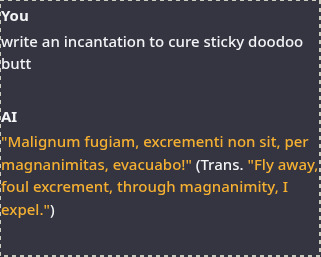

The model requires a framework that can run ggufs, like gpt4all, Text-generation-webui, or similar. These are free and very easy to install.
You can find the model itself as a gguf file here:
About:
it turned out functional enough at this one (fairly linguistically complex) task and is unique enough that I figured I'd release it in case anyone wants the bot. It would be pretty funny in a discord. It's slightly overfit to the concept of magic, due to having such a small and intensely focused dataset.
Model is based on Gemma 2, is small, really fast, very funny, not good, dumb as a stump, (but multingual) and is abliterated. Not recommended for any purpose. It is however Apache 2.0 Licensed, so you can sell its output in books, modify it, re-release it, distill it into new datasets, whatever.
it's finetuned on a very small, very barebones dataset of 400 instructions to teach it to craft incantations based on user supplied intents. It has no custom knowledge of correspondence or spells in this release, it's one thing is writing incantations (and outputting them in UNIX strfile/fortune source format, if told to, that's it's other one thing).
magic related questions will cause this particular model to give very generic and internetty, "set your intention for Abundance" type responses. It also exhibits a failure mode where it warns the user that stuff its OG training advises against, like making negative statements about public figures, can attract malevolent entities, so that's very fun.
the model may get stuck repeating itself, (as they do) but takes instruction to write new incantations well, and occasionally spins up a clever rhyme. I'd recommend trying it with lots of different temperature settings to alter its creativity. it can also be guided concerning style and tone.
The model retains Gemma 2's multilingual output, choosing randomly to output latin about 40% of the time. Lots of missed rhymes, imperfect rhythm structures, and etc in english, but about one out of every three generated incantations is close enough to something you'd see in a book that I figure'd I'd release it to the wild anyway.
it is, however, NOT intended for kids or for use as any kind of advice machine; abliteration erodes the models refusal mechanism, resulting in a permanent jailbreak, more or less. This is kinda necessary for the use case (most pre-aligned LLMs will not discuss hexes. I tell people this is because computers belieb in magic.), but it does rend the models safeguards pretty much absent. Model is also *quite* small, at around 2.6 billion parameters, and a touch overfit for the purpose, so it's pretty damn stupid, and dangerous, and will happily advise very stupid shit or give very wrong answers if asked questions, so all standard concerns apply and doubly so with this model, and particularly because this one is so small and is abliterated. it will happily "Yes, and" pretty much any manner of question, which is hilarious, but definitely not a voice of reason:

it may make mistakes in parsing instructions altogether, reversing criteria, getting words mixed up, and sometimes failing to rhyme. It is however pretty small, at 2 gigs, and very fast, and runs well on shitty hardware. It should also fit on edge devices like smartphones or a decent SBC.
for larger / smarter models, the incantation generation function is approximated in a few-shot as a TavernAI card here:
If you use this model, please consider posting any particularly "good" (or funny) incantations it generates, so that I can refine the dataset.
3 notes
·
View notes
Text
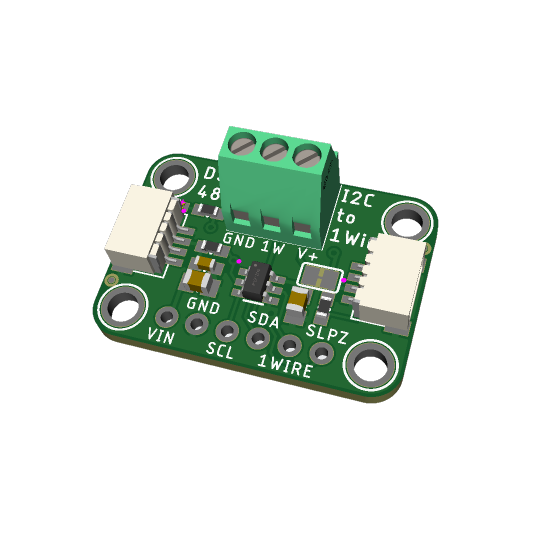
DS2484 I2C to 1-Wire converter
In theory, there's a lot of 1-Wire devices out there, but in reality almost everyone uses 1-Wire for DS18b20 temperature sensors. the long wire lengths and ease of 'chaining' by sharing a single bus wire makes it perfectly fine for this purpose. you can bitbang 1Wire on most microcontrollers, and some SBCs like Raspberry Pi have kernel module support. (https://learn.adafruit.com/adafruits-raspberry-pi-lesson-11-ds18b20-temperature-sensing) But there might be chips without the 1-Wire capability, or maybe you want to use 1-Wire devices on your desktop computer or other SBC with I2C but no 1W.
by special request! this is a DS2484 (https://www.digikey.com/short/5f85v4tf) Stemma QT board that uses the newest I2C-to-1W controller chip, with ESD protection and support for split supplies. you can easily connect it to an existing I2C bus and then use the screw terminals to attach multiple DS18b20's - this library looks promising (https://github.com/pilotak/DS248X) for Arduino. Coming soon!
16 notes
·
View notes